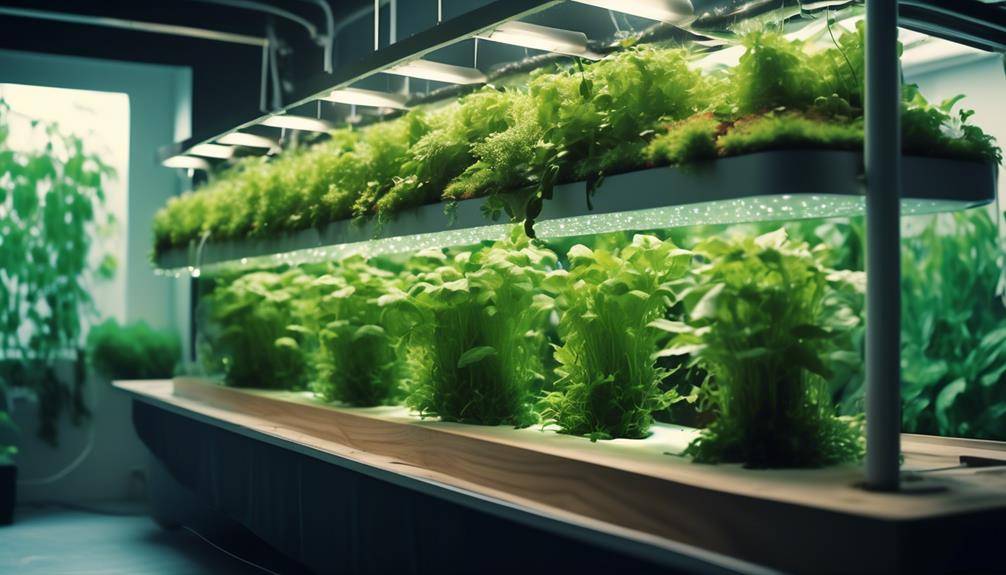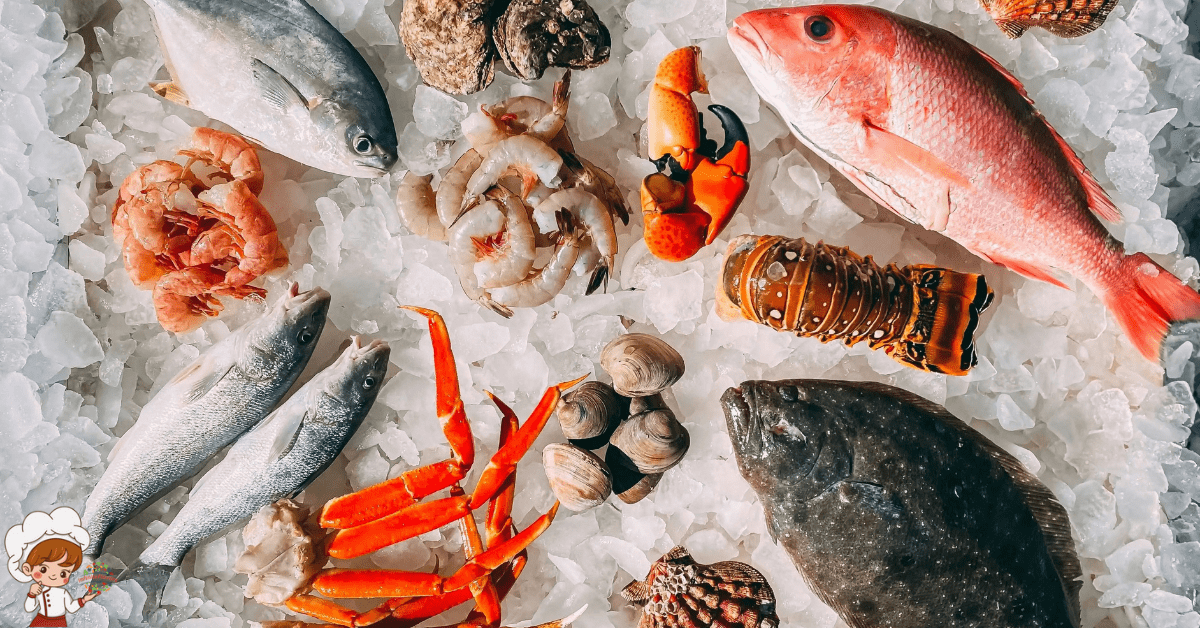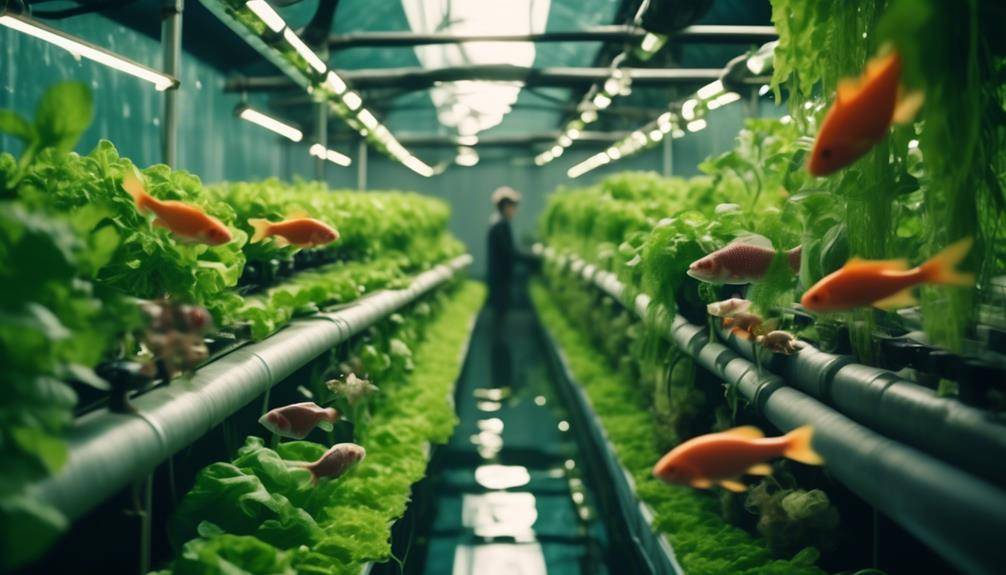Explore New Aquaponic Systems For Indoor Farming

They say that necessity is the mother of invention, and when it comes to indoor farming, aquaponic systems have emerged as a remarkable solution. With the ability to grow both fish and plants simultaneously, Aquaponic Systems For Indoor have gained popularity among those seeking a sustainable and efficient way to produce food. But how do aquaponic systems work, and what are the benefits they offer? In this discussion, we will explore the components of an aquaponic system, the importance of choosing the right fish and plants, and the essential steps to set up and maintain an indoor aquaponic system. Get ready to dive into the world of aquaponics and discover how it could revolutionize your approach to farming.
Benefits of Aquaponic Systems
Aquaponic systems offer numerous benefits for indoor farming, making them a highly efficient and sustainable method of cultivation. One of the key benefits of aquaponic systems is the ability to grow both plants and fish simultaneously. This symbiotic relationship between plants and fish creates a closed-loop system where the waste produced by the fish provides nutrients for the plants, while the plants filter and purify the water for the fish.
One of the main advantages of this system is its water efficiency. Aquaponic systems use up to 90% less water compared to traditional farming methods. The water is continuously recycled, reducing the need for constant irrigation and minimizing water waste. Additionally, the system eliminates the use of harmful chemical fertilizers, pesticides, and herbicides, making it an environmentally friendly and sustainable option.
Another benefit of aquaponic systems is the ability to grow a wide variety of plants. Leafy greens, herbs, vegetables, and even some fruits can thrive in these systems. This versatility allows farmers to cultivate a diverse range of crops, providing fresh and nutritious produce year-round.
In order to maintain optimal plant growth, it is crucial to monitor and control the pH levels in aquaponics. The pH level refers to the acidity or alkalinity of the water. Most plants prefer a slightly acidic to neutral pH range between 6.0 to 7.0. Monitoring pH levels ensures that the plants receive the appropriate nutrients and minerals they need for healthy growth. Regular testing and adjustment of pH levels are essential for maintaining a balanced and thriving aquaponic system.
Components of an Aquaponic System
Now that you understand the benefits of aquaponic systems for indoor farming, let’s explore the essential components that make up this efficient and sustainable cultivation method. When designing an indoor aquaponic system, it is crucial to maximize the use of space while maintaining the balance between the fish and plant components.
The first component of an indoor aquaponic system is the fish tank. This is where the fish are housed and play a vital role in providing the nutrients necessary for plant growth. The size of the fish tank will depend on the number and type of fish you plan to raise. It’s important to ensure that the tank is appropriately sized to accommodate the fish comfortably and facilitate their waste production.
Next, we have the grow bed. This is where the plants are grown and their roots are exposed to the nutrient-rich water from the fish tank. The grow bed can be made from various materials such as plastic, wood, or even repurposed containers. The size of the grow bed should be proportional to the fish tank to maintain the system’s balance.
To circulate water between the fish tank and the grow bed, a pump is required. The pump helps to ensure that the water is continuously moving, allowing the plants to receive the nutrients they need and preventing stagnation.
In addition to these key components, other essential elements include a biofilter to remove harmful substances from the water, aeration devices to ensure adequate oxygen levels for the fish, and a water quality testing kit to monitor and maintain optimal water conditions.
Choosing the Right Fish for Your System
To ensure the success of your indoor aquaponic system, it is crucial to carefully select the right fish species that will thrive in your specific setup. Fish selection is a critical step in the process, as it directly impacts the overall health and productivity of your aquaponic system. When choosing the fish for your system, consider the following factors:
- Fish compatibility: It is important to choose fish species that are compatible with each other and with the plants in your system. Some fish may eat or harm certain types of plants, while others may require specific water conditions that may not be suitable for all plants. Research and select fish species that will coexist harmoniously with the plants you wish to grow.
- Water requirements: Different fish have different water temperature, pH, and oxygen level requirements. It is essential to choose fish species that can thrive in the specific water conditions you can provide in your system. Consider factors such as the water temperature of your indoor space, the pH level of your water source, and the availability of oxygenation methods in your setup.
- Growth rate and harvestability: Depending on your goals and preferences, you may want to choose fish species that have a fast growth rate and are suitable for consumption. Some popular choices for aquaponic systems include tilapia, trout, and perch, as they grow quickly and are highly nutritious.
Selecting the Ideal Plants for Aquaponics
When selecting plants for your aquaponic system, it is important to consider their nutrient requirements and growth rate. Certain plants, like lettuce and herbs, are well-suited for aquaponics due to their low nutrient requirements and fast growth. However, it is important to strike a balance between the plants’ needs and the capacity of your system to provide those nutrients. By carefully selecting the ideal plants, you can ensure a successful and productive aquaponic system.
Best Aquaponic Plants
What are the ideal plants to select for aquaponics? When it comes to choosing the best aquaponic plants, there are several factors to consider. You want to select plant varieties that are well-suited for aquaponic systems and can thrive in the water-based environment. Here are three top choices that will not only optimize plant growth but also evoke a sense of satisfaction in your indoor farming journey:
- Leafy greens: Plants like lettuce, spinach, and kale are excellent options for aquaponics. They grow quickly and can be harvested multiple times, providing a continuous supply of fresh, nutrient-rich greens.
- Herbs: Basil, mint, and cilantro are great choices for aquaponics. They add a burst of flavor to your meals and have high market value, making them a profitable option for indoor farming.
- Strawberries: These delicious fruits can be grown vertically in aquaponic systems, maximizing space utilization. They will not only provide you with sweet, juicy berries but also add a touch of color to your indoor garden.
Plant Nutrient Requirements
As you continue your exploration of aquaponics, understanding the plant nutrient requirements is essential for selecting the ideal plants for your indoor farming system. Plants require various nutrients to grow and thrive, and deficiencies in these nutrients can lead to stunted growth or even death. Common plant nutrient deficiencies include nitrogen, phosphorus, potassium, and micronutrients such as iron, manganese, and zinc.
To address these deficiencies, organic fertilizers can be used in aquaponics systems. Organic fertilizers, derived from natural sources such as compost or animal manure, provide a balanced mix of essential nutrients for plants. They not only supply the necessary nutrients but also improve soil fertility and enhance microbial activity. By choosing plants that have specific nutrient requirements and using organic fertilizers, you can ensure optimal growth and health in your aquaponic system.
Growth Rate Considerations
To select the ideal plants for your aquaponics system, it is important to consider their growth rate. Conducting a growth rate analysis will help you optimize plant growth and ensure a successful indoor farming experience. Here are three key factors to consider:
- Time to maturity: Some plants take longer to reach maturity than others. Consider the duration from planting to harvest to determine whether the plant’s growth rate aligns with your goals and timeline.
- Yield per plant: Assess the potential yield per plant to maximize your production. Choose plants that offer a high yield within the available space in your aquaponics system.
- Nutrient requirements: Different plants have varying nutrient needs. Understanding the nutrient requirements of your chosen plants will help you provide the appropriate conditions for optimal growth.
Setting Up Your Indoor Aquaponic System
To set up your indoor aquaponic system, you will need to gather the necessary equipment, including a fish tank, grow bed, water pump, and air pump. Make sure to choose the right fish species that are suitable for aquaponics, such as tilapia or trout, considering factors like temperature preferences and compatibility with the plants you want to grow. By selecting the proper equipment and fish, you can ensure a successful and thriving indoor aquaponic system.
Equipment Required
You will need specific equipment to set up your indoor aquaponic system, ensuring optimal functionality and success. Here are three essential items you will need:
- Grow beds: These are containers where you will grow your plants. They can be made of plastic, wood, or even repurposed materials. Make sure they are large enough to accommodate your plants and have proper drainage.
- Fish tanks: The fish tank is where your aquatic animals, such as fish or shrimp, will live. It should be large enough to provide sufficient space for the fish and have a filtration system to maintain water quality.
- Pumps and aerators: These devices are crucial for circulating water in the system. The pump helps move water from the fish tank to the grow beds, while the aerator ensures adequate oxygen levels for the fish.
Choosing the Right Fish
Choosing the appropriate fish species is a critical step in setting up your indoor aquaponic system for optimal functionality and success. When selecting fish species for your aquaponic system, it is essential to consider their feeding requirements. Different fish species have varying dietary needs, and it is crucial to choose ones that can thrive in an aquaponic environment.
Tilapia is a popular choice for indoor aquaponic systems due to its ability to adapt to different water conditions and its omnivorous feeding habits. They are known to consume a wide range of plant matter and commercial fish feed. Another suitable option is trout, which require a high-protein diet and thrive in colder water temperatures. By understanding the feeding requirements of different fish species, you can ensure a balanced and efficient aquaponic system.
Maintaining Water Quality in Aquaponics
Maintaining water quality in aquaponics is essential for the overall health and productivity of the system. By ensuring that the water is clean and balanced, you can create an optimal environment for both the fish and plants to thrive. Here are some key factors to consider when it comes to water quality in your aquaponic system:
- Regular water testing: Regularly testing the water parameters is crucial to monitor the quality and make any necessary adjustments. Testing for parameters such as pH, ammonia, nitrite, and nitrate levels will help you determine if the water conditions are suitable for the fish and plants.
- pH control: pH plays a vital role in the overall health of your aquaponic system. It is recommended to maintain a pH range between 6.8 and 7.2 for optimal growth of both fish and plants. If the pH deviates from this range, it can negatively impact nutrient availability and the overall well-being of the organisms in the system. Monitoring and adjusting the pH as needed is essential for maintaining water quality.
- Maintaining proper nutrient levels: Nutrients are essential for plant growth in aquaponics. Monitoring and maintaining proper nutrient levels, including essential elements like nitrogen, phosphorus, and potassium, will ensure healthy plant growth and maximize productivity. Regularly testing and adjusting the nutrient levels will help maintain water quality and support the growth of both fish and plants.
Nutrient Management in Aquaponic Systems
To ensure optimal plant growth and productivity in your aquaponic system, effective nutrient management is crucial. Nutrient management involves maintaining the balance of essential nutrients in the system, promoting nutrient cycling, and ensuring water quality.
In an aquaponic system, nutrients are provided to the plants through fish waste, which is converted into a form that plants can easily absorb. This process, known as nutrient cycling, is the key to maintaining a healthy system. To promote nutrient cycling, it is important to ensure that the fish are fed a balanced diet that meets their nutritional needs. This will result in the production of nutrient-rich waste that can be utilized by the plants. Regular monitoring of nutrient levels in the water is also important to ensure that the plants are receiving an adequate supply of nutrients.
Water quality is closely linked to nutrient management in aquaponic systems. Poor water quality can hinder nutrient uptake by the plants and lead to stunted growth or nutrient deficiencies. Regular testing of water parameters, such as pH, ammonia, nitrite, and nitrate levels, is essential to maintain optimal water quality. Adjustments can be made as necessary to maintain the ideal conditions for plant growth.
Effective nutrient management in aquaponic systems requires careful monitoring and adjustment of nutrient levels and water quality. By promoting nutrient cycling and maintaining optimal water conditions, you can ensure that your plants receive the nutrients they need to thrive and produce a bountiful harvest.
Troubleshooting Common Aquaponic Issues
When troubleshooting common aquaponic issues, it is important to identify and address any problems that may be affecting the overall health and productivity of your system. By implementing common troubleshooting methods and taking preventative measures, you can ensure the smooth operation of your aquaponic system. Here are three key issues to watch out for and how to tackle them:
- Water quality: Poor water quality can lead to various problems in your aquaponic system. To prevent this, regularly test your water for pH levels, ammonia, nitrites, and nitrates. Adjust the pH as needed and ensure proper filtration and aeration to maintain optimal water conditions for your fish and plants.
- Nutrient deficiency: If you notice stunted growth, yellowing leaves, or poor plant health, it could indicate a nutrient deficiency. Monitor the nutrient levels in your system and adjust the fish feed or supplement with additional nutrients if necessary. Also, ensure that the fish feed you use provides the necessary nutrients for your plants.
- Pest and disease management: Pests and diseases can quickly spread and wreak havoc on your aquaponic system. To prevent common issues, practice good hygiene by regularly cleaning and disinfecting your system. Introduce beneficial predators or use organic pest control methods to keep pests in check. Additionally, closely monitor your plants for any signs of disease and promptly treat them to prevent further spread.
Aquaponic Systems For Indoor ; Frequently Asked Questions
Can I Use an Aquaponic System for Outdoor Farming?
Yes, you can use an aquaponic system for outdoor farming. Outdoor aquaponics offers several benefits, such as natural sunlight for plant growth and the ability to create a self-sustaining ecosystem.
What Are the Potential Drawbacks or Challenges of Maintaining an Indoor Aquaponic System?
To maintain an indoor aquaponic system, potential challenges include managing water quality, controlling temperature and humidity, and preventing pests. Solutions include regular water testing, proper insulation, and implementing pest control measures. Best practices involve optimizing lighting, nutrient levels, and plant spacing.
How Long Does It Take for Plants to Grow in an Aquaponic System?
On average, the growth rate of plants in an aquaponic system is influenced by various factors such as water quality, nutrient levels, temperature, and lighting. These factors determine how long plants take to grow.
Can I Use Any Type of Fish in My Aquaponic System?
You can use different fish species in your aquaponic system. It’s important to choose fish that are suitable for aquaponics and consider the optimal fish to plant ratio for your system’s efficiency.
How Often Should I Check and Adjust the Ph Levels in My Aquaponic System?
You should check and adjust the pH levels in your aquaponic system regularly to ensure optimal conditions for plant and fish health. The checking frequency depends on the specific needs of your system.
Conclusion
In conclusion, aquaponic systems offer a range of benefits for indoor farming. By combining aquaculture and hydroponics, these systems provide a sustainable and efficient way to grow both fish and plants. Choosing the right fish and plants, setting up the system correctly, and maintaining water quality are crucial for successful aquaponics. With proper nutrient management and troubleshooting, you can overcome common issues and enjoy a thriving indoor aquaponic system. Start your journey into indoor farming with aquaponics today!








